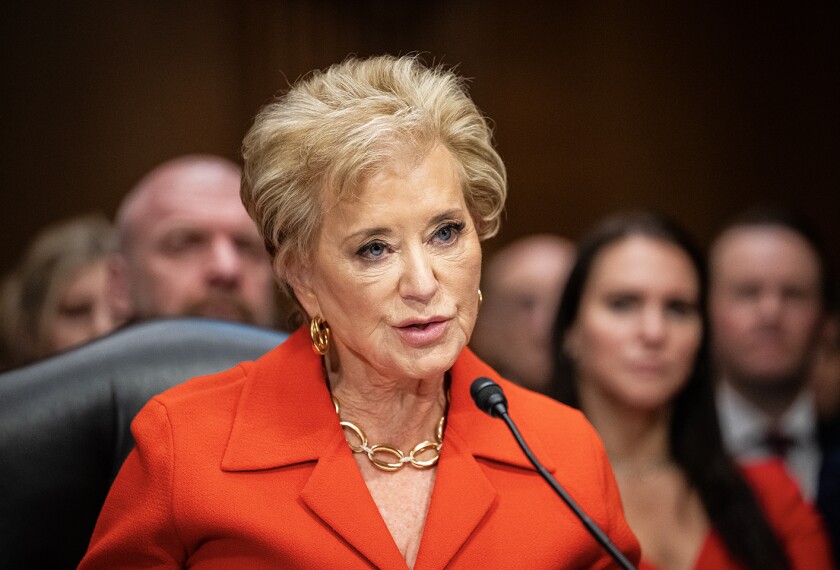To stay on top of the needs of a highly mobile enrollment, educators in the Aldine Independent School District in north Houston rely on frequent common assessments across subjects and grades to gauge how well students are learning. Aldine’s leaders use the short tests to check progress every three weeks in the 58,000-student system, which has a mobility rate of 30 percent.
The data those tests generate are parsed and scrutinized by teachers who use the results to tweak their instruction.
In Jenks, Okla., where students usually turn out some of the best test scores in the state, Superintendent Kirby Lehman and his team are using data to track their goal of getting all students to complete Algebra 1 by the end of 8th grade. In the 2007-08 school year, 78 percent of 8th graders in Jenks did so, and 97 percent of that group scored at least a “satisfactory” on the recent end-of-course exam in algebra, Mr. Lehman said.
Collecting data and analyzing it is the linchpin of both districts’ improvement initiatives, and part of the reason both have been held up as exemplars of “best practices” in using data to manage a wide range of school functions, especially those directly related to student achievement.
Swapping Ideas
For Aldine, Jenks, and nearly 70 other districts from around the country, a gathering here earlier this month was a chance to swap ideas and poach those practices from one another.
“Best practice” districts allocate more time for teachers and central-office staff members to review data each week.

SOURCE: American Productivity and Quality Center
Through the American Productivity and Quality Center, or APQC, a Houston-based nonprofit group that is beginning to work in public education after three decades of working with corporations to improve their performance and management strategies, the districts got to compare themselves on the practice of data-driven decisionmaking.
Taking a technique that is common in private enterprise—comparing management practices against those of the competition—APQC and its founder, C. Jackson Grayson, are pushing for public schools to do the same as a way to figure out what works best for increasing the numbers of students who do well in school and graduate from high school ready for college and jobs.
“The bottom line for public education is raising student achievement,” Mr. Grayson said in an interview. “School districts have been too isolated from one another for too long. When some of them have figured out processes and data usage to raise student performance, they should be able to share it with others.”
The districts used APQC’s “benchmarking” process to measure how they would stack up against one another. As part of that, district leaders completed detailed surveys with questions about the types of data they collect, what sort of software programs they use to manage and analyze the data, and how much time each week they allocate to teachers and central-office employees to review data. To take part in the study, districts each had to pay $7,500.
“It is very, very useful to look at what we are doing and how we are doing it against all these other districts,” said Joe Kitchens, the superintendent of the 3,300-student Western Heights school district in Oklahoma City, which was singled out by APQC as one of nine best-practice districts for data usage.
“I know we can always do better, but to hear about ideas from all these other districts gives me new ideas about how we can do better,” Mr. Kitchens said. “We’ve never really compared ourselves to anyone else before when it comes to data.”
Key Differences
In addition to the Aldine and Jenks districts, the other top systems identified for the APQC study were Iredell-Statesville, N.C.; Clark County, Nev.; Fulton and Gwinnett counties in Georgia; Community Consolidated School District 15 in Palatine, Ill.; and Montgomery County, Md.
The benchmarking study revealed some key differences between the best-practice districts and the rest of those that participated.
One was that the best-practice districts, on average, provided their elementary school teachers 3.1 hours a week to review and analyze student data, compared with 1.9 hours a week in the other districts. For central-office staff members, that figure was 7 hours a week in best-practice districts and 4.6 in the others.
Another finding showed that best-practice districts were much more likely to conduct data-specific professional-development sessions that focused on how to actually use the data, rather than on how operate the software technology that generates the information.
Many district leaders at the July 9-10 gathering said they wanted to hear more from the best-practice districts about how collecting and analyzing a trove of student data actually helped change the way teachers deliver instruction.
Now that leaders in each of the participating districts can evaluate how their systems stack up against some of their peers, APQC will forge ahead with the next phase in helping some of them improve. To that end, leaders of the center said they would enlist five or six districts to work with directly on a particular data-driven project or management process that the districts want to improve.
Karlene McCormick-Lee, an assistant superintendent in Nevada’s 309,000-student Clark County district, which includes Las Vegas, already had a project in mind.
“We want to work toward a model where we can get better data on our students from the foster-care and juvenile-justice systems,” she said. “Any data we can get from other agencies that impact the youth in southern Nevada.”





